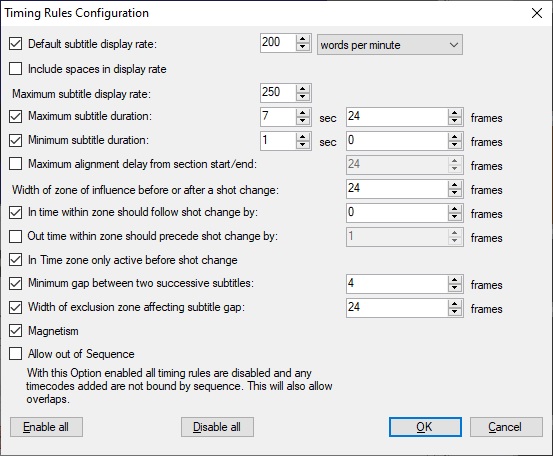 Timing Rules reference manual
Timing Rules reference manual
In this article:
Basics
The Timing Rules are applied in sequence, so the effect of one rule may undo the effect of a previous rule. The sequence is chosen so that the most important rules are applied last.
If a given Timing Rule is disabled in the Timing Rules dialogue then it is not applied.
Some rules behave differently when the aligner is running compared to when the user grabs an individual timecode – noted in context below.
The rules have built-in sanity checking to prevent any action from causing a subtitle to go out of sequence or to end up with negative duration: this may explain why some user actions are refused. These restrictions do not apply in Fix Mode.
The rules do provide a narrative to explain what they are doing, and people should be encouraged to consult this narrative to see what the system is doing.
Parameters
The screenshot below shows the Timing Rules parameters that can be supplied by the user:

Note that the values need to be reasonably self-consistent otherwise the results will not be as expected. For example:
The default text display rate should reflect the programme speech rate as modified by the expected editing percentage: if the programme is around 180wpm verbatim and the subtitlers are expecting to edit by around 10% maximum then a word rate of around 160wpm is sensible. Given the maximum number of subtitle rows plus the number of words per line on average, the nominal maximum duration can then be worked out.
If the programme has large numbers of short video sequences with lots of cuts, then the zone of influence of a given shot change should be shorter than for a programme with fewer cuts, otherwise the zones will tend to overlap.
Sequence
The processing sequence is as follows:
1) Sanity check
2) Section markers
3) Duration
4) Shot changes
5) Magnetism
6) Gaps
7) Addons
1) Sanity check
If the proposed timecode change would take the subtle out of sequence or give it a negative duration, then the change is ignored (does not apply in Fix Mode)
2) Section markers
When aligning, the subtitle at the start of a section should have an In time on or after the section start marker and within a defined distance of it. Similarly at the end of the section, the Out time must fall within a distance on or before the end marker. When sliding, a subtitle should not entirely pass out of the enclosing section.
3) Duration
If the duration is too short and there is space after the Out time, Out is extended to a limit of the next In. If duration is still too short and there is space before the In time, and only when aligning, In is reduced to a limit of previous Out. Otherwise report that the subtitle is hemmed in. If the duration is too long, reduce Out. Note that If the next In is floating or when working in Fix Mode, the Out time of the current subtitle is allowed to extend beyond it.
4) Shot changes
In time: Find the nearest shot changes before and after In for which In is in zone of influence. If In is already at correct distance after, do nothing. If only one shot change, clip to it unless a sequence error would occur. If between two shot changes, clip to the later one unless within 1/3 distance of the earlier in which case clip to that instead. Ignore any change if it takes the In time to within 5 frames of next In time or causes a sequence error. If aligning, re-check duration and re-float if now too short.
Out time: Find the nearest shot changes before and after Out for which Out is in zone of influence. If Out is already at correct distance before, do nothing. If only one shot change, clip to it unless a sequence error would occur. If between two shot changes, clip to the later one unless within 1/3 distance of the earlier in which case clip to that instead. Ignore any change if it causes a sequence error.
5) Magnetism
If the original gap before In or after Out was the minimum gap, deem boundary to be magnetic. If magnetic In is moved and previous Out is not explicit then move previous Out to follow it unless that would extend the previous duration to more than twice its float value (or 2 seconds, if float value is very small). If magnetic Out is moved and next In is not explicit then move next In to follow it unless that would extend the next duration to more than twice its float value (or 2 seconds, if float value is very small).
6) Gaps
In: The precedence rules are that an explicit In overrides a previous Out; an explicit previous Out overrides an In, otherwise a previous Out is overridden by a new In. If In changes then remove any overlap using above precedence and then reset the gap to prescribed minimum if too short or if in exclusion zone. If there is an intervening shot change then double the gap provided it would not create a sequence error.
Out: The precedence rules are that an explicit Out overrides a next In; otherwise Out is overridden by next In. If Out changes then remove any overlap using above precedence and then reset the gap to prescribed minimum if too short or if in exclusion zone. If there is an intervening shot change then double the gap provided it would not create a sequence error.
7) Add-ons
Allow for the special case of Add-ons where the Out times of all the subtitles in the Add-on sequence are the same